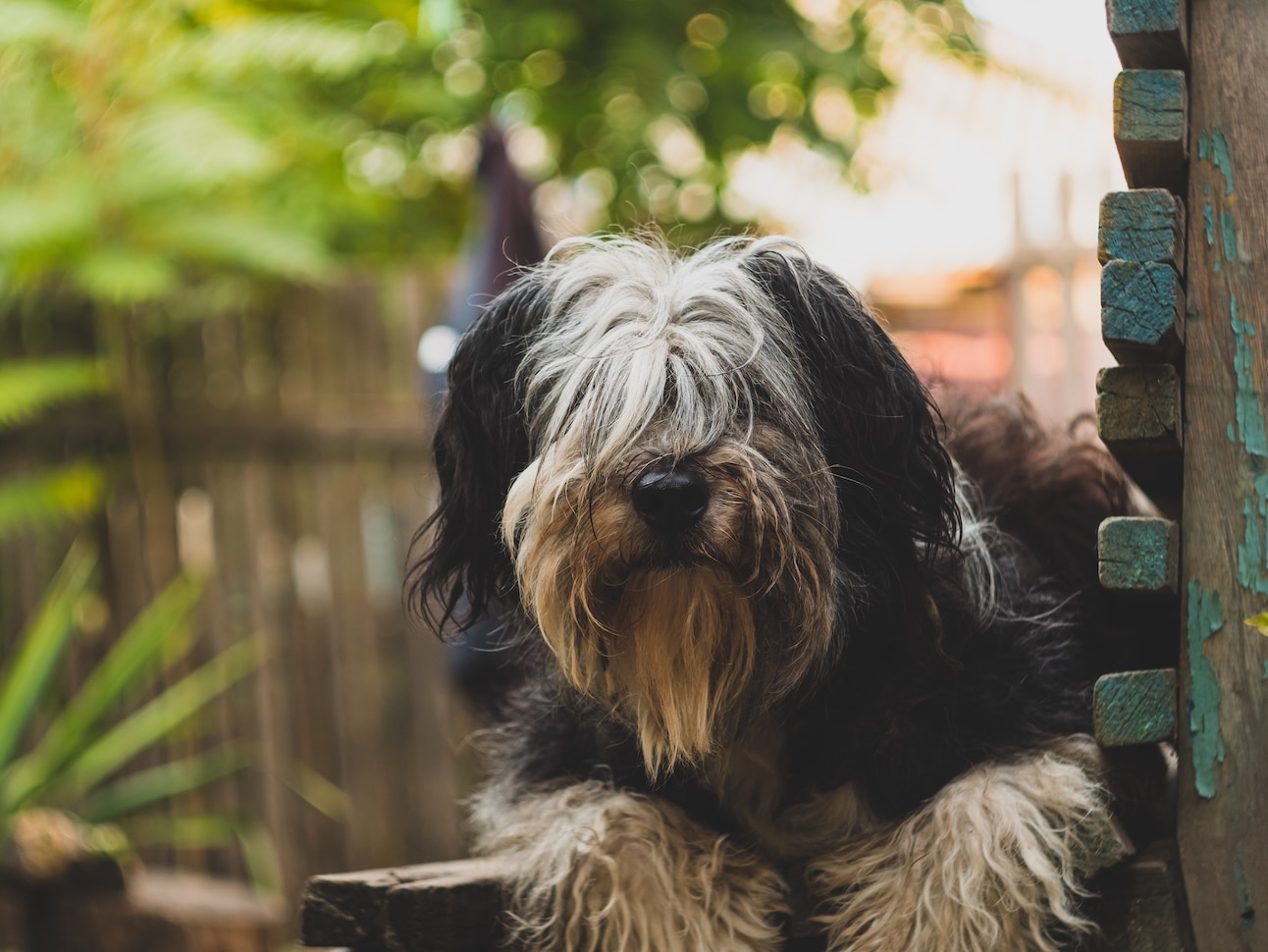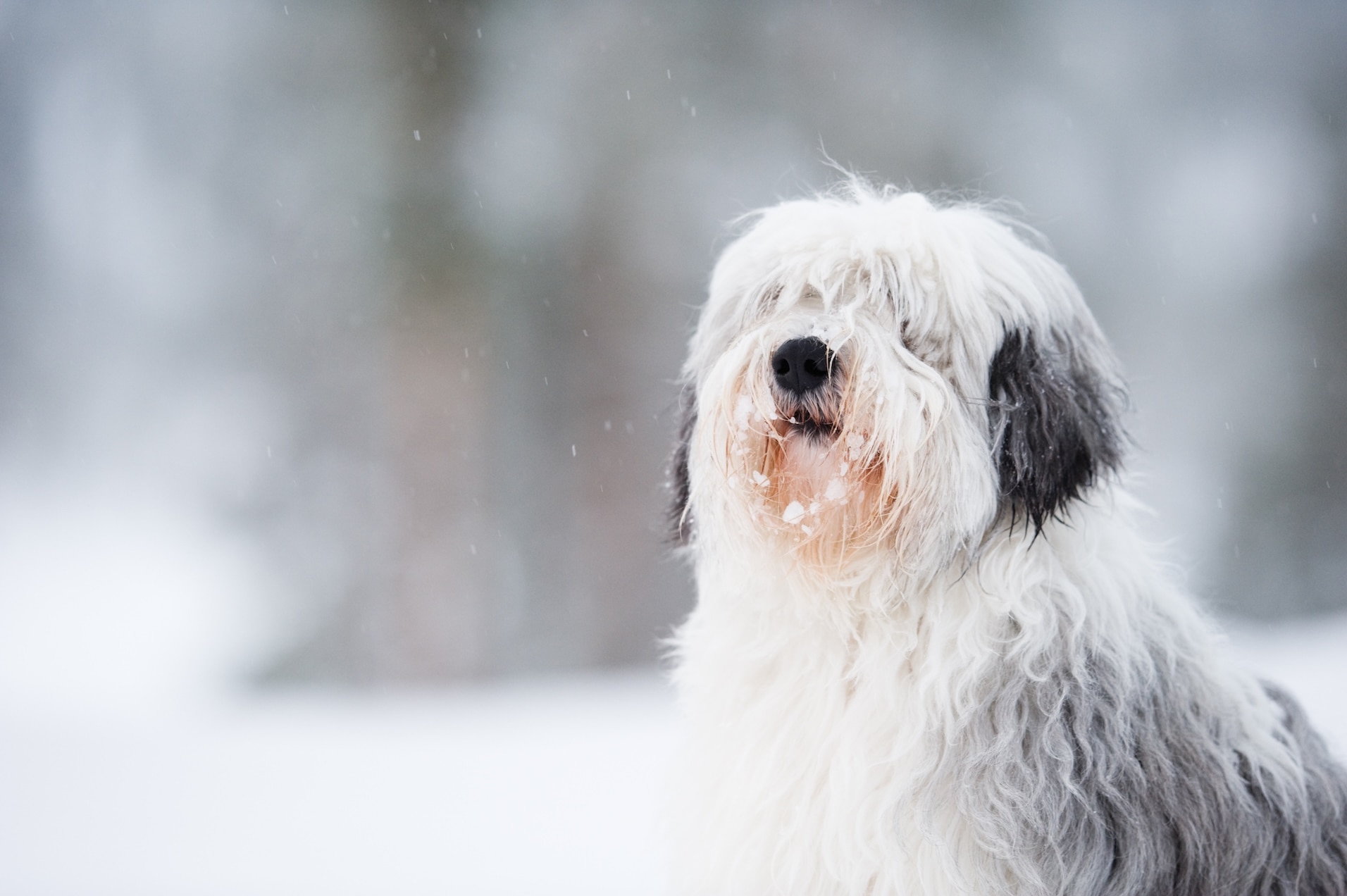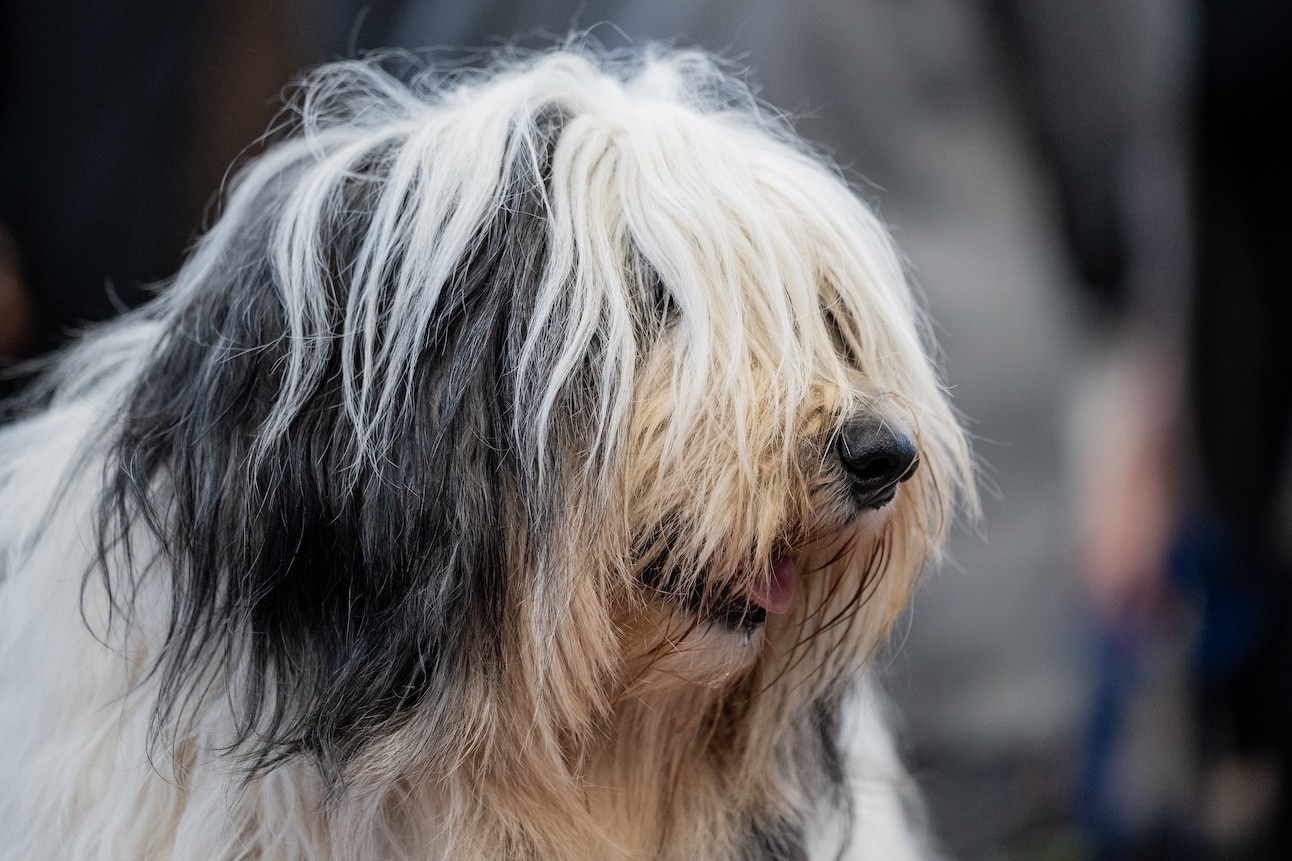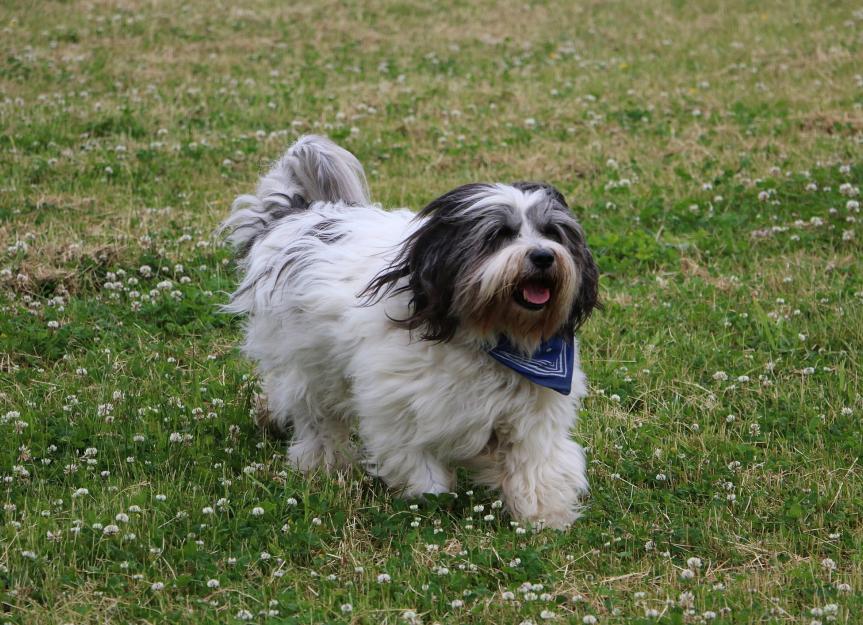The Polish Lowland Sheepdog is a shaggy, medium-sized herding breed known for their intelligence, loyalty, and lively temperament.
Originating in Poland, the Polish Lowland Sheepdog was bred to herd and guard sheep. As a descendant of the Hungarian Puli, Polish Lowland Sheepdogs (also called Polish Owczarek Nizinny, or PON), have a dense, long, and shaggy coat. That moplike appearance isn’t just cute—it protects the dogs from harsh weather and rugged terrain as they work in the Polish lowlands.
Caring for a Polish Lowland Sheepdog
As a herding breed, the PON has a moderate to high energy level, and thrives with daily exercise and mental stimulation. Regular walks and active play sessions help keep them both physically fit and mentally engaged. Without enough activity, your dog may become bored.
Along with daily exercise, Polish Lowland Sheepdogs require care for their shaggy double coat. Brushing your dog several times a week is needed to prevent tangles and matting, and occasionally trimming the fur around the eyes, ears, and feet helps maintain cleanliness.
Polish Lowland Sheepdogs are highly intelligent and have excellent memories, which can make training both rewarding and challenging. Like all dogs, PON respond well to positive reinforcement, but they may have an independent streak that requires patience and consistency.
But with the right balance of structure, affection, and activity, Polish Lowland Sheepdogs make a devoted addition to any attentive household.
Polish Lowland Sheepdog Health Issues

Polish Lowland Sheepdogs are a relatively healthy dog breed with an average lifespan of 12–14 years. While not overly prone to health problems, they can be predisposed to a few hereditary conditions, so regular veterinary checkups are a smart consideration for pet parents.
Hip Dysplasia
Hip dysplasia is a hereditary condition where the hip joint develops improperly, causing pain and, if left untreated, arthritis in dogs.
Symptoms often include:
-
-
Walking with a bunny hop-like gait
-
Trouble standing up, jumping up, or going up and down stairs
Management typically involves weight control, joint supplements, anti-inflammatory medication, or surgery if the case is severe.
Progressive Retinal Atrophy (PRA)
Progressive retinal atrophy is a genetic eye disease where the eye’s retina gradually breaks down, eventually leading to blindness. Although rare in Polish Lowland Sheepdogs, the initial symptoms often include night blindness and difficulty navigating low-lit environments.
Though there’s no cure for PRA, blind dogs can live long, happy, and relatively normal lives with support from their family.
Hypothyroidism
Hypothyroidism can occur in a Polish Lowland Sheepdog when their thyroid gland doesn’t produce enough hormones, leading to symptoms such as lethargy, weight gain, hair loss, and recurring skin infections and ear infections.
Fortunately, hypothyroidism is easily managed with lifelong daily medication to regulate hormone levels. Regular veterinary monitoring is essential to maintain the correct dosage and manage symptoms effectively, ensuring affected dogs can live active, comfortable lives.
Whatever food you choose for your dog, it needs to be formulated for their current life stage. Polish Lowland Sheepdog puppies, for example, need a puppy-specific dog food.
How To Feed a Polish Lowland Sheepdog
Polish Lowland Sheepdogs do best on a consistent feeding routine with two measured meals per day (in the morning and evening). But Polish Lowland Sheepdog puppies may need smaller meals—about three per day—until they’re 6 months old. Then, they can reduce to a twice-daily schedule.
Free-feeding isn’t recommended, as this can lead to obesity in dogs.
How Much Should You Feed a Polish Lowland Sheepdog
Determining how much to feed your dog involves assessing your dog’s age, weight, activity level, and overall health. Start with the feeding guidelines listed on your chosen food’s packaging, then adjust based on your dog’s physical condition. Your vet is your best resource.
Nutritional Tips for Polish Lowland Sheepdogs
Supplements can be beneficial and help support the overall health of your Polish Lowland Sheepdog. But always consult your veterinarian before adding any supplements to your PON’s diet. Healthy Polish Lowland Sheepdogs will typically get all the nutrients they need from their AAFCO-compliant dog food.
Here are some supplement options:
-
Glucosamine and chondroitin help maintain joint function and mobility, which is especially helpful for dogs with hip dysplasia or arthritis.
-
Probiotics support digestion, nutrient absorption, and a healthy immune system.
Behavior and Training Tips for Polish Lowland Sheepdogs
Polish Lowland Sheepdog Personality and Temperament

Polish Lowland Sheepdogs have everything that hardworking herders need to do their job well: intelligence, loyalty, and intuition. But they are also an affectionate dog who can thrive off the farm—if they’re in the right family environment.
With moderate to high energy levels, PONs do best with daily routines, lots of mental stimulation, and regular activities like walks, playtime, or dog sports like agility.
Polish Lowland Sheepdog Behavior
Polish Lowland Sheepdogs are vocal dogs who often bark to alert, but this barking can become excessive if they’re allowed to grow bored. Pet parents can reduce nuisance barking by offering their dog engaging toys, playing mentally enriching games, and keeping their PON worn out with regular exercise.
They may be a bit standoffish with strangers at first, but proper socialization and patience usually help them build trust and warm up to new people. With early exposure and slow introductions, they typically do well with children and other pets.
Polish Lowland Sheepdog Training
The Polish Lowland Sheepdog’s intelligence and independence make training rewarding, but training this smart dog can also be challenging. PONs excel in training activities that engage both their mind and body. They enjoy having a job to do and respond best when training is fun, structured, and mentally stimulating.
Always use positive reinforcement methods that focus on consistency, praise, and rewards like special toys or training treats.
Do not allow your Polish Lowland Sheepdog puppy to engage in behaviors that you don’t want them to have as an adult. While mouthing your hands might be cute when they’re little, you don’t want this 30- to 50-pound grownup to play with humans that way.
With fairness, consistency, and plenty of positive interaction, Polish Lowland Sheepdogs become eager, responsive learners and well-mannered companions.
Fun Activities for Polish Lowland Sheepdogs
Polish Lowland Sheepdog Grooming Guide

The Polish Lowland Sheepdog has a dense double coat made of a coarse topcoat and a soft undercoat, giving the breed an iconic shaggy look.
Despite having a lot of hair, Polish Lowland Sheepdogs don’t shed as much as some other dog breeds. However, regular brushing is a must to keep the coat healthy.
Coat Care
The Polish Lowland Sheepdog’s fur is at high risk of matting, so brushing them at least two to three times a week is a must. However, daily care with a rake brush, like the Frisco Shedding Rake Brush, is ideal—especially behind the ears, under the legs, and around the collar.
While not required, professional grooming can help keep your dog’s coat tangle-free, particularly if the coat is kept shorter for easier upkeep.
Skin Care
Polish Lowland Sheepdogs aren’t prone to specific skin problems. But because of their thick coat, it’s important to keep them well-groomed to prevent matting, hot spots, or skin irritation.
It’s also best to bathe your dog every four to six weeks using a gentle, dog-specific shampoo to avoid drying out the skin. If your take your Polish Lowland Sheepdog to a groomer, they can bathe your dog for you.
Eye Care
To help your dog see, keep the long facial hair around their eyes trimmed or held up with a hair tie.
They aren’t prone to excessive tear staining, either, but keep the eye area clean and free of buildup. Regularly check for signs of redness, discharge, or irritation, and gently wipe the area with a damp, soft cloth if needed.
Ear Care
Because of their propensity for hypothyroidism, be alert for signs of an ear infection in your Polish Lowland Sheepdog. Contact your vet if you notice any redness, odor, or debris buildup in your dog’s ears.
Your vet may recommend cleaning your dog’s ears with a dog-friendly ear cleaner as part of your grooming routine.
Considerations for Pet Parents

The ideal home for a Polish Lowland Sheepdog is with an active family who is prepared to provide their dog with consistent exercise, structured training, and regular grooming. Pet parents should be ready to meet this breed’s moderate-to-high energy levels with daily walks, engaging activities, and mental stimulation.
Training must be positive and consistent, as Polish Lowland Sheepdogs are smart but can be independent-minded and strong-willed. If their needs are met, PON dogs can thrive in many different environments, from rural areas to cities.
Polish Lowland Sheepdog FAQs
Are Polish Lowland Sheepdog good family dogs?
Yes, Polish Lowland Sheepdogs can make excellent family dogs when their care needs are met. They are affectionate, intelligent, and loyal companions who bond deeply with their families.
How much does a Polish Lowland Sheepdog cost?
Do Polish Lowland Sheepdogs bark a lot?
Polish Lowland Sheepdogs are naturally alert and tend to be vocal, often barking to alert their families to unfamiliar noises, people, or activities. While not excessive barkers by nature, they can become problematic barkers if bored, under-exercised, or lack proper training.
What’s the difference between a Bearded Collie and a Polish Lowland Sheepdog?
While the Bearded Collie and the Polish Lowland Sheepdog are both shaggy herding dogs, they are two distinct breeds. Bearded Collies, originally from Scotland, are typically more outgoing and exuberant. In contrast, PONs hail from Poland and tend to become calmer and more serious as they mature.
Physically, Polish Lowland Sheepdogs are smaller and more compact, standing 18–20 inches tall and weighing 35–50 pounds. Bearded Collies are taller and leaner, with a longer, more angular build.



